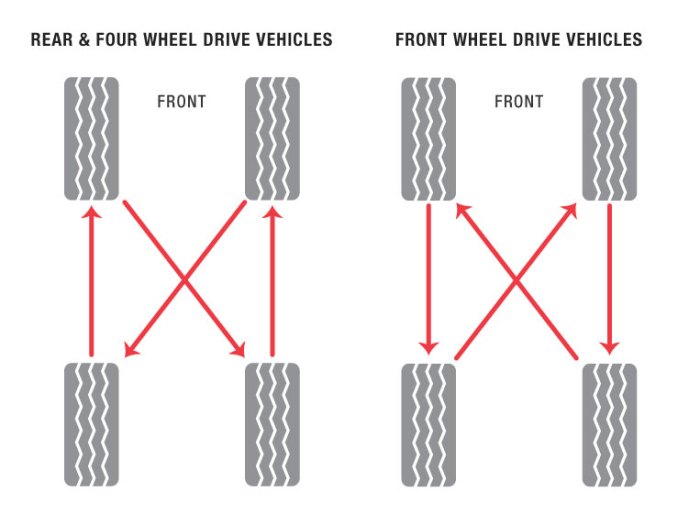
Imagine your car gliding effortlessly down the road, handling with precision and consuming less fuel. This ideal driving experience can be a reality with a simple yet often overlooked practice: regular tire rotation. Tire rotation is a fundamental maintenance task that ensures your vehicle’s tires wear evenly, leading to a multitude of benefits that extend far beyond just tire longevity.
By rotating your tires at regular intervals, you’re essentially distributing the wear and tear across all four tires, maximizing their lifespan and optimizing overall vehicle performance. This simple act can lead to enhanced handling, improved fuel efficiency, and a smoother, more comfortable ride, ultimately contributing to a safer driving experience.
Improved Tire Lifespan
Rotating your tires regularly is a simple yet crucial practice that can significantly extend the life of your tires. This practice ensures even wear across all tires, maximizing their lifespan and enhancing overall vehicle performance.
Uneven Wear and its Impact
Uneven wear on tires can lead to various issues that compromise both performance and safety. When tires wear unevenly, it can cause:
- Reduced Traction: Uneven tire wear can lead to reduced traction, particularly during braking, acceleration, and cornering, making it difficult to control the vehicle.
- Increased Fuel Consumption: Tires with uneven wear create increased rolling resistance, leading to higher fuel consumption and reduced fuel efficiency.
- Premature Tire Failure: Uneven wear can weaken the tire structure, increasing the risk of tire failure, blowouts, and accidents.
- Ride Discomfort: Uneven tire wear can lead to a rough and uncomfortable ride, causing vibrations and noise.
- Uneven Braking: Uneven wear can affect braking efficiency, leading to uneven braking forces and potential instability.
Benefits of Tire Rotation
Tire rotation is a preventative measure that helps distribute wear evenly across all tires. By rotating your tires regularly, you can:
- Extend Tire Lifespan: By rotating your tires, you ensure that all tires wear down at the same rate, maximizing their overall lifespan. This can save you money in the long run by delaying the need for premature tire replacement.
- Improve Handling and Control: Even tire wear ensures consistent grip and traction, enhancing vehicle handling and control, especially during critical maneuvers.
- Enhance Fuel Efficiency: Even wear reduces rolling resistance, leading to improved fuel efficiency and reduced fuel consumption.
- Promote a Smoother Ride: Even wear ensures a more comfortable ride by eliminating vibrations and noise caused by uneven tire wear.
- Increase Tire Safety: By preventing uneven wear, tire rotation minimizes the risk of tire failure, blowouts, and accidents.
Enhanced Vehicle Handling and Stability
Regular tire rotation plays a crucial role in ensuring your vehicle handles predictably and remains stable, particularly in challenging driving conditions. This practice promotes balanced tire wear, directly impacting your vehicle’s responsiveness and control.
The Impact of Balanced Tire Wear
Balanced tire wear, achieved through regular rotation, is the cornerstone of enhanced handling and stability. When all four tires have similar tread depth and wear patterns, they distribute weight and grip evenly, allowing for precise steering and controlled braking. This balanced contact with the road surface enables the vehicle to respond smoothly to driver inputs, ensuring a predictable and safe driving experience.
Effects of Uneven Tire Wear
Uneven tire wear, on the other hand, can significantly compromise a vehicle’s handling and stability. Tires with varying tread depths or wear patterns will have inconsistent grip levels, making the vehicle prone to:* Over-steering: This occurs when the rear wheels lose traction, causing the vehicle to skid sideways. Uneven tire wear on the rear axle can lead to unpredictable over-steering, especially during cornering or sudden maneuvers.
Under-steering
This happens when the front wheels lose traction, causing the vehicle to continue in a straight line even when the steering wheel is turned. Uneven wear on the front tires can result in under-steering, making it difficult to steer around obstacles or navigate tight corners.
Reduced braking performance
Tires with uneven wear will have varying stopping distances, leading to longer braking times and reduced overall braking efficiency. This can be particularly dangerous in emergency situations where quick and effective braking is crucial.
Increased risk of hydroplaning
Uneven tire wear can reduce the tire’s ability to channel water away from the contact patch, increasing the risk of hydroplaning, especially during wet conditions. Hydroplaning occurs when a vehicle loses contact with the road surface due to a buildup of water between the tires and the road.
Benefits of Tire Rotation for Handling and Stability
Tire rotation not only prolongs tire life but also enhances a vehicle’s handling and stability in several ways:* Improved steering response: With balanced tire wear, the steering wheel provides more precise feedback, allowing for smoother and more controlled steering inputs. This ensures the vehicle responds accurately to driver commands, enhancing overall driving control.
Enhanced cornering stability
Balanced tire wear promotes even weight distribution and grip, allowing the vehicle to corner smoothly and predictably. This improves the vehicle’s stability and reduces the risk of skidding or losing control.
Consistent braking performance
By ensuring all four tires have similar tread depth, tire rotation guarantees consistent braking performance across all wheels. This results in shorter stopping distances and increased safety, especially during emergency braking situations.
Reduced risk of hydroplaning
Tires with balanced wear patterns can effectively channel water away from the contact patch, minimizing the risk of hydroplaning. This is crucial for maintaining control during wet weather conditions.
Increased Fuel Efficiency
Properly inflated and evenly worn tires contribute significantly to better fuel economy. Tires that are under-inflated or have uneven wear patterns increase rolling resistance, making it harder for your vehicle to move. This results in your engine having to work harder, consuming more fuel in the process.
Impact of Uneven Tire Wear on Fuel Consumption
Uneven tire wear, often caused by improper tire pressure or misalignment, can lead to increased fuel consumption. When tires wear unevenly, the contact patch between the tire and the road surface becomes smaller and less efficient. This reduces the tire’s ability to grip the road, increasing rolling resistance and requiring the engine to work harder, leading to higher fuel consumption.
Optimizing Fuel Efficiency Through Tire Rotation
Tire rotation helps to ensure even wear across all tires. By rotating tires regularly, you distribute the wear more evenly, preventing any one tire from wearing out faster than the others. This promotes better fuel efficiency by minimizing rolling resistance and optimizing the tire’s contact patch with the road surface.For example, a study by the National Highway Traffic Safety Administration (NHTSA) found that under-inflated tires can reduce fuel economy by up to 3%.
This means that if you drive 15,000 miles per year, under-inflated tires could cost you an extra $100 in fuel costs.Another study by the U.S. Department of Energy found that properly inflated tires can improve fuel economy by up to 3.3%. This means that if you drive 15,000 miles per year, properly inflated tires could save you an extra $110 in fuel costs.Tire rotation is a simple and cost-effective way to improve fuel efficiency and save money on gas.
By rotating your tires regularly, you can help to ensure that your tires are wearing evenly and that your vehicle is getting the best possible fuel economy.
Improved Ride Comfort

Regular tire rotation plays a crucial role in enhancing the ride comfort of your vehicle. It ensures even tire wear, which directly translates to a smoother and more enjoyable driving experience.
Impact of Balanced Tire Wear on Ride Quality
Balanced tire wear is essential for a comfortable ride. When all four tires wear down at a consistent rate, they maintain the proper contact patch with the road surface. This uniform contact ensures a smoother ride, minimizing vibrations and bumps.
Impact of Uneven Tire Wear on Ride Quality
Uneven tire wear can significantly impact ride quality. When tires wear down unevenly, it can lead to:* Increased Vibration: Uneven tire wear creates imbalances, resulting in increased vibrations that are transmitted through the steering wheel, chassis, and even the seats.
Uneven Handling
Uneven tire wear can lead to inconsistencies in how the vehicle handles, making it difficult to maintain control, especially at higher speeds.
Reduced Stability
Uneven tire wear can affect the vehicle’s stability, making it more susceptible to swaying or drifting, particularly during cornering or sudden maneuvers.
How Tire Rotation Enhances Ride Comfort
Tire rotation helps to distribute wear evenly across all four tires. By rotating the tires according to the manufacturer’s recommendations, you can:* Reduce Vibration: Even tire wear minimizes the imbalances that cause vibrations, resulting in a smoother and quieter ride.
Improve Handling
Consistent tire wear ensures that the vehicle handles predictably and smoothly, providing a more comfortable and enjoyable driving experience.
Enhance Stability
Even tire wear contributes to improved vehicle stability, making the ride more comfortable and secure, especially during cornering or sudden braking.
Enhanced Safety
Rotating your tires regularly is not just about extending their lifespan, it’s also a crucial factor in ensuring the safety of you and your passengers. Balanced tire wear is essential for safe driving, and uneven wear can have serious consequences.
Impact of Uneven Tire Wear on Braking Performance
Uneven tire wear can significantly compromise your vehicle’s braking performance. When tires wear unevenly, they lose their ability to grip the road surface effectively, particularly during braking. This can lead to increased stopping distances and reduced control over the vehicle, especially in emergency situations. For instance, imagine driving at highway speeds and needing to brake suddenly. With uneven tire wear, your vehicle may take longer to stop, potentially putting you and others at risk.
How Tire Rotation Enhances Safety
Rotating your tires regularly helps ensure that all four tires wear down at a similar rate. This even wear pattern maximizes the contact patch between the tires and the road, enhancing traction and stability. With balanced tire wear, your vehicle responds predictably to steering and braking inputs, giving you greater control and confidence on the road.
Business Services

Regular tire rotation is not just a maintenance task for personal vehicles; it holds significant value for businesses across various industries. By ensuring optimal tire performance, businesses can achieve operational efficiency, reduce costs, and enhance safety for their employees and assets.
Benefits of Regular Tire Rotation for Various Industries
Tire rotation plays a crucial role in maximizing tire lifespan, enhancing vehicle handling, and improving fuel efficiency, all of which translate into tangible benefits for businesses. The following table highlights the specific advantages and potential cost savings for different industries:
| Industry | Specific Benefits | Potential Cost Savings |
|---|---|---|
| Aerospace and Defense |
|
|
| Agriculture and Forestry |
|
|
| Automobiles and Motorcycles |
|
|
| Chemicals and Allied Products |
|
|
Regular tire rotation is a simple yet powerful practice that significantly impacts your vehicle’s performance, longevity, and safety. By ensuring even tire wear, you can enjoy a smoother ride, better fuel economy, and enhanced handling, ultimately prolonging the life of your tires and maximizing your investment. So, next time you’re at your mechanic, don’t forget to ask about tire rotation – it’s a small step that can lead to big benefits for you and your vehicle.
FAQ Compilation
How often should I rotate my tires?
The recommended tire rotation interval varies depending on the vehicle and tire type. However, most manufacturers recommend rotating tires every 5,000 to 7,500 miles. It’s best to consult your owner’s manual or your mechanic for specific guidance.
What are the different tire rotation patterns?
There are several tire rotation patterns, including X-pattern, front-to-back, and side-to-side. Your mechanic will determine the best pattern for your vehicle based on tire type and wear.
Can I rotate my tires myself?
While you can technically rotate your tires yourself, it’s generally recommended to have a professional mechanic do it. This ensures the tires are properly balanced and rotated according to the correct pattern.
Does tire rotation affect my warranty?
Tire rotation is typically covered under most tire warranties. However, it’s always best to check with your tire manufacturer or dealer to confirm.





